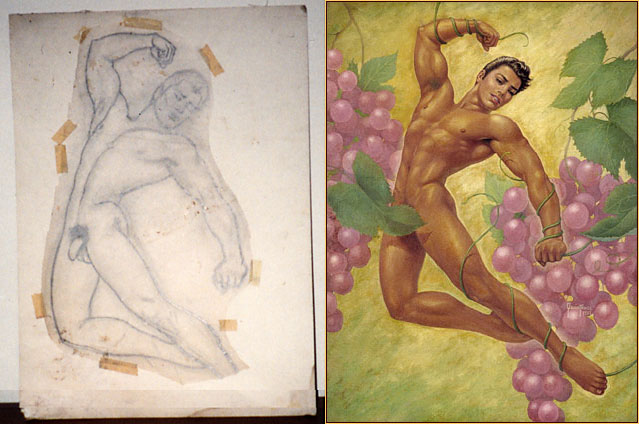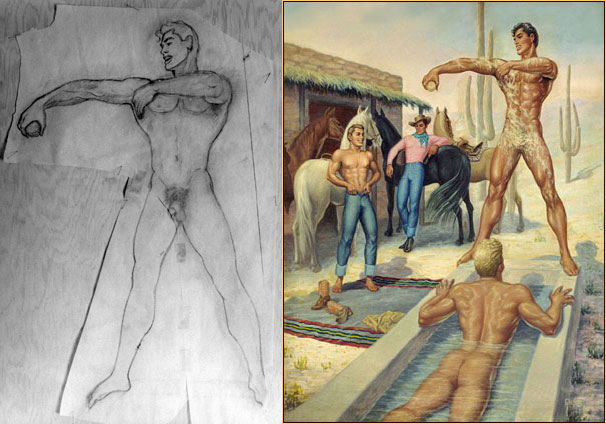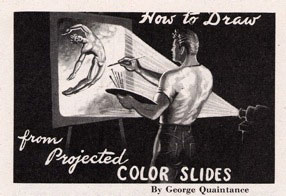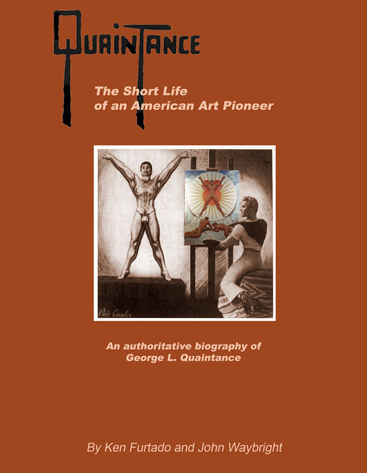 Though their subject matter may have been worlds apart, two techniques of Normal Rockwell and George Quaintance invite comparison. Both attended the illustrious Art Students League of New York, an establishment that has been around since 1875. Rockwell's attendance there preceded Quaintance's by nine years — 1910 versus 1919 — but they appear to have "taken home" some of the same learning.
Though their subject matter may have been worlds apart, two techniques of Normal Rockwell and George Quaintance invite comparison. Both attended the illustrious Art Students League of New York, an establishment that has been around since 1875. Rockwell's attendance there preceded Quaintance's by nine years — 1910 versus 1919 — but they appear to have "taken home" some of the same learning.
The first technique was the execution of a detailed, full-sized sketch in charcoal on onionskin or tracing paper that would then be transferred to canvas. The artist would pin or tape the sketch to the canvas, then place transfer paper (similar to the carbon paper we used with typewriters) between the sketch and the canvas and, by re-tracing the original, transfer the design to the canvas.
 The accompanying images show two such surviving sketches by Quaintance that would become the principal figures of the paintings Bacchant and Morning. (As an aside, we note that the sketches show frontal nudity, though the completed canvases did not.)
The accompanying images show two such surviving sketches by Quaintance that would become the principal figures of the paintings Bacchant and Morning. (As an aside, we note that the sketches show frontal nudity, though the completed canvases did not.)
Another method employed by both artists and advertised by them was drawing by projected image. A popular early projector for home use that was sold by Bausch & Lomb was the Balopticon, a precursor of the slide projector. According to ads of the day, it could be used "For the showing of prints, photos, postals, etc., or for lantern slides."
![]() There's an old photo of Rockwell painting with the aid of the Balopticon. The caption below the image reads, "Here I am working with the aid of the Balopticon which operates like the old magic lantern projecting a sketch or photograph not larger than five and one-half inches to almost any size you desire. The further away from the Balopticon the reflected image is, the greater the enlargement."
There's an old photo of Rockwell painting with the aid of the Balopticon. The caption below the image reads, "Here I am working with the aid of the Balopticon which operates like the old magic lantern projecting a sketch or photograph not larger than five and one-half inches to almost any size you desire. The further away from the Balopticon the reflected image is, the greater the enlargement."
A similar photo appears in volume 2, #1 (Feb. 1952) of Physique Pictorial, accompanied by a chatty art lesson from George Quaintance. The text is reproduced here verbatim, including errors.
"Just as a language can be learned by speaking it (even though the student is ignorant of its gramatical construction, etc.) so can fundamental figure drawing be learned by the simple expedient of drawing on cop of a projected image. With no other instruction, a student can gradually learn to solve all of the problems of proportions, foreshortening, coloring, etc. However, projected slide drawing is not limited to amateur artists alone. Many seasoned professionals take advantage of the procedure when faced with a particularly perplexing problem.
![]() "Using slides is far less expensive than employing live models, and it is possible to use difficult interrupted action poses in which no model could be successfully posed. Slides are now being offered by most of the advertisers in Physique Pictorial and others are now planning to offer them. Wide expansions of slide libraries are being assembled to more adequately meet artists varied requirements.
"Using slides is far less expensive than employing live models, and it is possible to use difficult interrupted action poses in which no model could be successfully posed. Slides are now being offered by most of the advertisers in Physique Pictorial and others are now planning to offer them. Wide expansions of slide libraries are being assembled to more adequately meet artists varied requirements.
"Many amateurs have the mistaken idea that a good projector must be a costly item, but this is not so. There are some excellent projectors on the market for less than ten dollars. (A.M.G. will send you one postpaid for $9.95). Your local camera store may even have one for a few dollars less. However, for this application it is important that you do not get a projector with too high a wattage (over100w) since your slide may he projected for a hall-hour or more and might be damaged by heat. A blower-cooled higher wattage projector might make enough noise to annoy you. Other projectors costing up to $40 may have a very sleek appearance, but often cause overheating of the slide. So don't go by price alone, but explain to the dealer the performance you expect.
 "For drawing purposes your projector need not be set up in a completely dark room, though subdued lighting is desirable. Have a handy switch by your easel with which you can turn off your projector and turn on an inspection light so you can check your progress. Draw your outlines in soft lead pencil and add colors later. In adding the colors, most artists prefer to project the slide on a separate screen or wall close to their easel so they can constantly compare the coloring.
"For drawing purposes your projector need not be set up in a completely dark room, though subdued lighting is desirable. Have a handy switch by your easel with which you can turn off your projector and turn on an inspection light so you can check your progress. Draw your outlines in soft lead pencil and add colors later. In adding the colors, most artists prefer to project the slide on a separate screen or wall close to their easel so they can constantly compare the coloring.
"At the beginning, the tyro artist should follow closely the outlines of the original projection, but with just a little practice he can successfully add and omit factors which will greatly improve upon the original. With sufficient patience, YOU will soon be able to draw magnificent figures which will satisfy your own personal ideals in a manner no other artist could achieve.
"So go to it and good luck! And should you have any questions on this or other art problems, feel free to write anytime to QUAINTANCE FINE ART STUDIOS . Be sure to enclose a self-addressed stamped envelope."
Ironically, the Physique Pictorial article in which Quaintance promotes the use of projection uses Bacchant as an example when we know that he did not use projection when he drew this image.
Thank you to my friend L in Paris who suggested this article.

